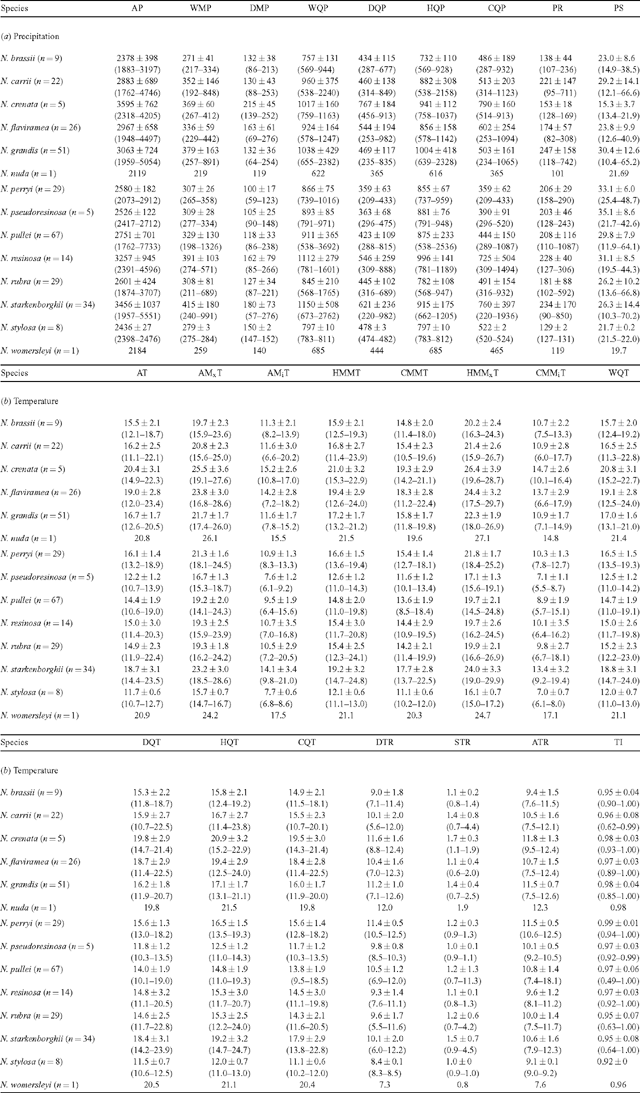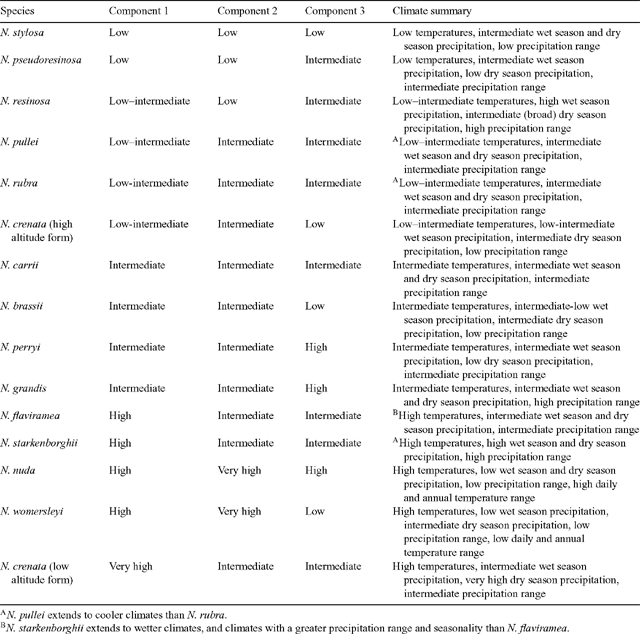Phytogeography and climate analysis of Nothofagus subgenus Brassospora in New Guinea and New Caledonia
Jennifer Read A D , Geoffrey S. Hope B and Robert S. Hill CA School of Biological Sciences, Monash University, Vic. 3800, Australia.
B Department of Archaeology and Natural History, Research School of Pacific and Asian Studies, Australian National University, Canberra, ACT 0200, Australia.
C School of Earth and Environmental Sciences, University of Adelaide, Adelaide, SA 5005, and South Australian Museum, North Terrace, Adelaide, SA 5000, Australia.
D Corresponding author. Email: jenny.read@sci.monash.edu.au
Australian Journal of Botany 53(4) 297-312 https://doi.org/10.1071/BT04155
Submitted: 30 September 2004 Accepted: 15 February 2005 Published: 24 June 2005
Abstract
Nothofagus subgenus Brassospora now occurs only in New Guinea and New Caledonia, but is well known from fossil deposits of South America, New Zealand, Antarctica and Australia. It is commonly used for palaeoclimatic interpretation, but the climate characteristics of the extant species have not been described. In this paper we used the climatic estimation software, BIOCLIM, to derive a climate profile of 24 variables for each of the 14 species of Nothofagus native to New Guinea, and lapse rates and isohyet maps to describe the annual mean temperature and rainfall range of the five species native to New Caledonia. The New Guinea species occur at annual mean temperatures ranging from 10.6 to 23.5°C, with annual precipitation of 1762–7733 mm. The first three axes of a principal components analysis explained 85% of the total variation, the first axis comprising temperature variables, the second comprising precipitation range and precipitation of the wet season, and the third axis comprising dry-season precipitation and annual and diurnal temperature range. Some species had distinct combinations of positions along these component axes, indicating clear niche differentiation with respect to climate. The New Caledonian species occur at annual mean temperatures of 14.5–23.5°C, and annual precipitation of c. 1500–3500 mm. Although there was no significant difference in annual mean temperature and precipitation between the New Guinea and New Caledonian species, comparison of median values across species suggests specialisation of most New Caledonian species towards slightly drier conditions than the New Guinea species that occur at similarly high annual mean temperatures. Use of subgenus Brassospora to interpret palaeoclimates should take into account the variation in climate experienced across the range of extant species.
Acknowledgments
We gratefully acknowledge the assistance provided by staff at the Lae Herbarium (Papua New Guinea Department of Forests), the National Research Institute of Papua New Guinea for permission to undertake research in Papua New Guinea, the staff of the Herbarium of IRD, Institut de Recherche pour le Développement, Centre de Nouméa, New Caledonia. We thank Henry Nix (Centre for Resource and Environmental Studies, ANU) for his inputs to this study. This research has been funded with the support of the Australian Research Council.
Anon, (1981).
Ash, J (1982). The Nothofagus Blume (Fagaceae) of New Guinea. In ‘Biogeography and ecology of New Guinea’. pp. 355–380. (Dr W. Junk Publishers: The Hague)
Ballard, C (2000). Condemned to repeat history? ENSO-related drought and famine in Irian Jaya, Indonesia, 1997–98. In ‘El Niño–history and crisis’. pp. 123–148. (White Horse Press: Cambridge, UK)
Brass LJ
(1959) Results of the Archbold Expeditions. No. 79. Summary of the fifth Archbold Expedition to New Guinea (1956–1957). Bulletin of the American Museum of Natural History 118, 1–70.

Brookfield H
(1989) Frost and drought through time and space: what were conditions like when the High Valleys were settled? Mountain Research and Development 9, 306–321.

Brown MJF, Powell J
(1973) Frost in the highlands. Australian Geographer 12, 367–369.

Brown M, Powell JM
(1974) Frost and drought in the highlands of Papua New Guinea. Journal of Tropical Geography 38, 1–6.

Busby JR
(1986) A biogeoclimatic analysis of Nothofagus cunninghamii (Hook.) Oerst. in southeastern Australia. Australian Journal of Ecology 11, 1–7.

Crook KAW, Belbin L
(1978) The southwest Pacific area during the last 90 million years. Journal of the Geological Society of Australia 25, 23–40.

Dettmann ME,
Pocknall DT,
Romero EJ, del Carmen Zamaloa M
(1990)
Nothofagidites Erdtman ex Potonié, 1960: a catalogue of species with notes on the paleogeographic distribution of Nothofagus Bl. (Southern Beech). New Zealand Geological Survey Paleontological Bulletin 60, 1–79.

Grubb PJ
(1971) Interpretation of the ‘Massenerhebung’ effect on tropical mountains. Nature 229, 44–45.

Grubb PJ
(1977) Control of forest growth and distribution on wet tropical mountains: with special reference to mineral nutrition. Annual Review of Ecology and Systematics 8, 83–107.
| Crossref | GoogleScholarGoogle Scholar |

Grubb, PJ ,
and
Stevens, PF (1985). The forests of the Fatima Basin and Mt Kerigomna, Papua New Guinea, with a review of montane and subalpine rainforests in Papuasia. (Department of Biogeography and Geomorphology Publication, BG/5, Australian National University: Canberra)
Hill RS
(2001) Biogeography, evolution and palaeoecology of Nothofagus (Nothofagaceae): the contribution of the fossil record. Australian Journal of Botany 49, 321–332.
| Crossref | GoogleScholarGoogle Scholar |

Hill, RS ,
and
Dettmann, ME (1996). Origin and diversification of the genus Nothofagus. In ‘The ecology and biogeography of forests’. pp. 11–24. (Yale University Press: New Haven, CT)
Hill RS, Jordan GJ
(1993) The evolutionary history of Nothofagus (Nothofagaceae). Australian Systematic Botany 6, 111–126.
| Crossref |

Hill RS, Read J
(1991) A revised infrageneric classification of Nothofagus (Fagaceae). Botanical Journal of the Linnean Society 105, 37–72.

Hill, RS ,
Truswell, EM ,
McLoughlin, S ,
and
Dettmann, ME (1999). Evolution of the Australian flora: fossil evidence. In ‘Flora of Australia. Vol. 1’. 2nd edn pp. 251–320. (ABRS/CSIRO: Melbourne)
Hope, GS (1980). New Guinea mountain vegetation communities. In ‘The alpine flora of New Guinea. Vol. 1’. pp. 153–222. (J. Cramer: Vaduz)
Hope, GS (1996a). History of Nothofagus in New Guinea and New Caledonia. In ‘The ecology and biogeography of forests’. a. pp. 257–270. (Yale University Press: New Haven, CT)
Hope, GS (1996b). Quaternary change and historical biogeography of Pacific Islands. In ‘The origin and evolution of the Pacific Island biotas’. b. pp. 165–190. (SPB Publishing: Amsterdam)
Hynes RA
(1973) Ecology of Nothofagus forest in Central New Guinea. MSc Thesis
(University of Papua:
New Guinea)
Hynes, RA (1974). Altitudinal zonation in New Guinea Nothofagus forests. In ‘Altitudinal zonation in Malesia’. Transactions of the 3rd Aberdeen–Hull symposium on Malesian ecology pp. 75–109. (Department of Geography: University of Hull: UK)
Jaffré, T (1980). Étude écologique du peuplement végétal des sols dérivés de roches ultrabasiques en Nouvelle Calédonie. Collections Travaux et Documents de l’ (ORSTOM no. 124, ORSTOM: Paris)
Kershaw, AP (1988). Late Cainozoic vegetation of Australasia: 20 million to 20 thousand years B.P. In ‘Vegetation history’. pp. 237–306. (Kluwer: Dordrecht, The Netherlands)
Manos PS
(1997) Systematics of Nothofagus (Nothofagaceae) based on rDNA spacer sequences (ITS): taxonomic congruence with morphology and plastid sequences. American Journal of Botany 84, 1137–1155.

Martin PG, Dowd JM
(1993) Using sequences of rbcL to study phylogeny and biogeography of Nothofagus species. Australian Systematic Botany 6, 441–447.
| Crossref |

McAlpine, JR ,
Keig, G ,
and
Falls, R (1983).
Morat P,
Veillon J-M, MacKee HS
(1986) Floristic relationships of New Caledonian rainforest phanerogams. Telopea 2, 631–679.

Mueller-Dombois, D ,
and
Ellenberg, H (1974).
Nix, HA (1986). A biogeographic analysis of elapid snakes. In ‘Atlas of elapid snakes of Australia’. pp. 4–15. (Australian Flora and Fauna Series No. 7. (Australian Government Publishing Service: Canberra)
Paijmans, K (1976). Vegetation. In ‘New Guinea vegetation’. pp. 23–104. (CSIRO and ANU Press: Canberra)
Read J, Hope GS
(1989) Foliar frost resistance of some evergreen tropical and extratropical Australasian Nothofagus species. Australian Journal of Botany 37, 361–373.

Read, J ,
and
Hope, GS (1996). Ecology of Nothofagus forests of New Guinea and New Caledonia. In ‘The ecology and biogeography of forests’. pp. 200–256. (Yale University Press: New Haven, CT)
Read J,
Hope GS, Hill RS
(1990) The dynamics of some Nothofagus-dominated rain forests in Papua New Guinea. Journal of Biogeography 17, 185–204.

Setoguchi H,
Ono M,
Doi Y,
Koyama H, Tsuda M
(1997) Molecular phylogeny of Nothofagus (Nothofagaceae) based on the atpB–rbcL intergenic spacer of the chloroplast DNA. Journal of Plant Research 110, 469–484.

Soepadmo, E (1972). Fagaceae. In ‘Flora Malesiana Vol. 7’. Series 1. pp. 265–403. (Wolters-Noordhoff Publishing: Groningen, The Netherlands)
Swenson U,
Backlund A,
McLoughlin S, Hill RS
(2001)
Nothofagus biogeography revisited with special emphasis on the enigmatic distribution of subgenus Brassospora in New Caledonia. Cladistics 17, 28–47.
| Crossref | GoogleScholarGoogle Scholar |

van Steenis CGGJ
(1971) Revision of Nothofagus in New Caledonia. Adansonia 11(Series 2), 615–624.

van Steenis CGGJ
(1975) Miscellaneous notes on New Guinea plants XI. Blumea 22, 170–172.

van Steenis CGGJ
(1986) An interesting new species of Nothofagus from New Guinea (Fagaceae). Kew Bulletin 41, 732.

Trescases, JJ (1975). L’évolution géochemique supergène des roches ultrabasiques en zone tropicale. (Mémoire ORSTOM no. 78.
Truswell EM
(1993) Vegetation responses in the Australian Tertiary in response to climatic and phytogeographic forcing factors. Australian Systematic Botany 6, 533–557.
| Crossref |


|

|

|


